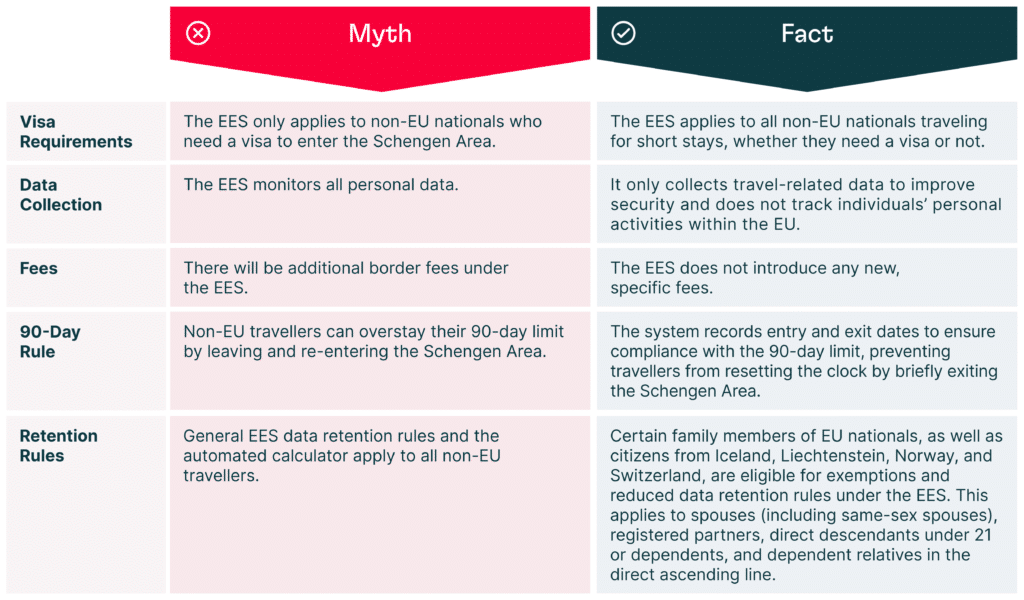With contributions by Claudia Gualdi
The European Union has postponed the launch of its Entry/Exit System (EES), previously scheduled to go live on 10 November 2024. The system is designed to enhance security and streamline travel for non-EU nationals entering and leaving the Schengen Area. However, key EU member states — Germany, France and the Netherlands — are not prepared to integrate it, leading to the delay. Their current systems are not yet compatible with the centralised EES technology provided by EU-Lisa. These three countries handle 40% of the affected passenger traffic.
According to Commissioner Ylva Johansson, the EU is considering a phased launch. Even if this happens, 10 November 2024 is no longer a viable start date. There is no new timeline for when the system will be fully operational.
What is the EES?
Delayed four times now, the EES will automate border control for non-EU travellers entering the Schengen Area for short stays (up to 90 days in any 180-day period). A non-EU national refers to individuals who are not citizens of an EU country, Iceland, Liechtenstein, Norway or Switzerland.
The system will register travellers’ complete name, travel document type, biometric data —including facial images and fingerprints— and the date and place of entry and exit. It will also record refusals of entry. This data will be stored in a secure database for three years and will help authorities prevent overstays and terrorism, manage irregular migration and reduce identity fraud.
The EES aims to eliminate manual passport stamping, streamline the process, and reduce wait times, especially during peak travel periods. It is expected to impact approximately 700 million travellers to the EU annually.
Navigating Passport Control with Self-Service Systems and Officials
Travellers at select border crossings with biometric passports can use self-service systems. Those with non-biometric passports must go through regular lanes, where passport control officials will check their documents. It is important to remember that, even with digital border checks, officials can still decide to allow or deny entry.
To find out how many days they can still stay in European countries, people can use the upcoming EES online tool or the equipment set up at some borders. They can also ask passport control officers for this information.
Common Misconceptions
Misunderstandings about the new system have caused some confusion. Travel companies need to ensure their travellers understand the process clearly. Below are a few common misconceptions:
How to Prepare for the EES Rollout
For travel organisations, particularly those managing international bookings or cross-border travel, the delayed implementation means the transition period and any potential border disruptions are postponed for now. However, companies should remain prepared for a phased rollout in the future.
Impact on Business
- Travel Itineraries and Processing Times: Once live, the EES will initially create longer wait times at border control points due to technical adjustments. Travel companies should proactively inform clients of potential delays and adjust travel plans accordingly, especially during the initial rollout phase.
- Customer Experience: As biometric data collection becomes a requirement, non-EU travellers may experience some initial confusion or concerns about privacy. Travel companies should offer clear, concise information to reassure customers. They should also explain the benefits of the EES in terms of security and future travel efficiency.
- System Compatibility: Ensure that booking and client management systems are updated to accommodate the new requirements. Integrating biometric checks and understanding border policies will improve the customer journey.
- Visa & Compliance: The EES will soon work alongside the ETIAS system, which will require visa-exempt travellers to secure travel authorisation before entering the Schengen Area.
What are the obligations for transport carriers?
Transport carriers must use the carrier interface to check if travellers with a short-stay visa for one or two entries have exhausted their permitted entries. This check should be done no earlier than 48 hours before departure. Carriers must ensure that only authorised personnel have access to this interface and implement access control measures to prevent unauthorised access, including authentication and regular access rights reviews.
Travel companies need to prepare for the EES and understand its effects, as it will change border control processes and the traveller experience at airports, train stations and land borders. Here’s how:
- Educate your team and travellers about the upcoming EES and the potential impact on entry/exit times.
- Update your booking and support systems to reflect new border control requirements, including biometric data checks.
- Coordinate with airport and transport authorities to stay informed of the latest developments and communicate updates to your clients.
Travel companies that proactively prepare for its introduction will be better equipped to handle the changes and provide a smoother experience for their clients. Stay updated on future EU announcements regarding the EES launch on official EU sources.

